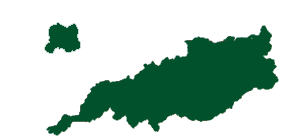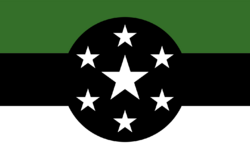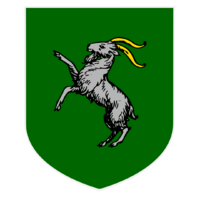Swinas: Difference between revisions
TentuberrAlt (talk | contribs) mNo edit summary |
TentuberrAlt (talk | contribs) mNo edit summary |
||
| Line 1: | Line 1: | ||
{{Infobox country | {{Infobox country | ||
| conventional_long_name = Federal Republic of Swinas | | conventional_long_name = Federal Republic of Swinas | ||
| native_name = Uet Republyiče | | native_name = Uet Republyiče Poedeera ot Sviinas | ||
| common_name = Swinas | | common_name = Swinas | ||
| image_flag = [[File:SwishFlag.png|250px]] | | image_flag = [[File:SwishFlag.png|250px]] | ||
Revision as of 00:50, 7 September 2024
Federal Republic of Swinas Uet Republyiče Poedeera ot Sviinas | |
|---|---|
 | |
| Capital | Tuppelt |
| National Language | Swiina, Common, German |
| Ethnic groups |
|
| Demonym(s) | Swiina |
| Government | Federal Republic |
• First Consul | Eduard Hoffman |
• Second Consul | Lorenzo Ricci |
| Area | |
• Total | 985,095 km2 (380,347 sq mi) |
| Population | |
• 2020 census | 42,299,153 |
| GDP (nominal) | estimate |
• Total | 448,984,350,000 |
| Currency | Swiina Diiydut, Swiina Diiyduttip (SD, SDP) |
| Driving side | right |
| Calling code | +59 |
The Federal Republic of Swinas, known to the native Sviina speakers as the "Parnaas Tulapayttap bet Sviinas" is a nation with a rich history and language, being born in what is now the Deserts of Swinas, before migrating to the more arable lands of the northern Sviina plains, where the capital of Tuppelt is located. Whilst the mainland speaks mostly Sviina, the island of Nordinsel is far different, being much more Germanic culturally and linguistically. The Federal Republic is led by the two Consuls of the Republic, along with the Provincial Governors of each Province. Nordinsel has special autonomy laws that allow it to govern itself more freely than other mainland provinces for several reasons. Though there is no official symbol of Swinas, the Sviina people are often associated with rams, with this being reflected both on the Coat of Arms and in their currency, as Diiydut is Sviina for Ram. Swinas is entirely located in the continent of Hiraethia, spanning an area of 985,095 square kilometers.
History
Rise of the Early Sviina (3000 BCE - 1000 BCE)
During this time, the Sviina People would still primarily live in the desert, growing religiously, linguistically, culturally, and technologically, just as other regions of the continent of Hiraethia were doing. The Sviina would begin establishing tribes across the desert, relying on camels for transportation. The Sviina people would thrive in the desert, but when news had arrived that arable land was discovered north, many nomadic tribesmen began the long trek north towards the much more arable land. By 1000 BCE, the desert and the plains were evenly spread in terms of population, thus marking the end of the Rise of the Early Sviina.
The Pvixga Dvaxpat (775 BCE - 324 BCE)
300 years after the great migration from the desert, the plains would begin developing much faster agriculturally and technologically, being in much arable land and being much closer to more developed neighbors, they would quickly begin to form centralized kingdoms across the plains, with the eventual rise of one kingdom in particular; the Pwixga Dwaxpat, or, the Kingdom of Pwixga. The Kingdom of Pwixga, based in North-West Sviinas, would begin conquest of Cape Kresta,
Government
The Government of Swinas will now be explained in full depth. The Government of Swinas is divided into 3 echelons, the first being the Consuls, the next being the Senate, and finally the Provinces. The consuls are the easiest to explain, and will be discussed first. The requirements to become a consul are that you must be at least 30 years old, you must have been a member of the senate for 5 years, and you must be born in Swinas or your parents were born in Swinas. The two consuls share the power to veto and approve legislation, but if the Senate counters the veto with a 75% majority then it is passed regardless. The two consuls must both sign legislation before it is passed. Then there is the Senate. The Modern Senate is comprised of 100 members, but this number has changed throughout history. To be a member of the Senate you must be 20 years old. A senator has one vote each, and a simple majority of 51/100 can pass a law. If both consuls veto a law, then it can be countered by a 75/100 majority, which will override the Consul Veto and force the law to be passed. The Senate has some limitations per what laws it can pass due to the constitution, mainly that it cannot impede upon the established Bill of Laws. Laws in the Bill from the beginning of the Federal Republic cannot be easily removed, but newer ones are easier to remove.
Lastly there is the provinces. Each province has a governor who can choose to follow or not follow certain legislation passed by the Senate. In addition, the Governor acts as the speaker of the Province, as there is also a Provincial Assembly in every province which has a member count proportional to it's population. These provincial assemblies can only pass laws which involve the province they are in, however. The consuls, senate, and provinces altogether make up the Modern Government of Swinas, which has been in place for 400 years and is still stable today.

